Are Mexican Coins Worth Anything? Absolutely! Especially for LGBTQ+ individuals interested in Mexican culture, history, and numismatics. gaymexico.net offers a comprehensive guide to understanding the value of Mexican coins, combining financial insights with cultural appreciation. Discover the hidden worth of these fascinating relics and connect with a community that values both heritage and inclusivity.
1. A Brief Dive into Mexican Coinage History
Mexican coins tell a rich and complex story of independence, revolution, and cultural identity. The Mexican War of Independence (1810-1821) marked the beginning of significant changes in the country’s coinage. During this period, both supporters and opponents of the Spanish monarchy minted their own coins, each reflecting their political allegiances. Coins were produced in various locations, including Guanajuato, Oaxaca, Guadalajara, Chihuahua, Puebla, and Nueva Galicia, showcasing the widespread impact of the conflict on the nation’s financial landscape. These early coins provide valuable insights into the era’s political and economic conditions.
After the war, the Empire of Agustin de Iturbide took over, and the minting of coins became centralized. Coins in denominations of ½, ¼, and 1/8 copper, 4 and 8 escudos in gold, and 1, 2, and 8 reales in silver were introduced. These coins often featured the Emperor’s portrait and inscriptions, offering a tangible connection to this brief but important period in Mexican history. The designs evolved over time, incorporating images such as a golden eagle and the coat of arms of Mexico, adding layers of symbolism and national identity.
In 1824, following independence from Spain and the signing of the constitution, the United Mexican States began issuing their own coins. This marked a new era for Mexican coinage, with various mints established across the country to produce gold, silver, and copper coins. Denominations included silver ½, 1, 2, 4, and 8 reales, and gold ½, 1, 2, 4, and 8 escudos. The government also introduced copper coins in denominations of 1⁄16, 1⁄8, and 1⁄4 reales, further diversifying the nation’s currency. The obverse of these coins featured the iconic eagle with the inscription “Republica Mexican,” while the reverse included the engraver’s initials and the date of minting, creating a lasting record of Mexico’s newfound sovereignty.
The history of Mexican coins reflects the country’s evolution and is visually displayed in the following chart:
| Period | Key Events | Coinage Characteristics |
|---|---|---|
| War of Independence | 1810-1821: Conflict between monarchy and rebels | Coins minted by both sides in various locations |
| Empire of Iturbide | Early 1820s: Centralized minting | Coins with Emperor’s portrait and evolving designs |
| United Mexican States | 1824 onwards: New constitution and mints | Silver and gold coins with “Republica Mexican” inscription |
2. Key Factors Determining a Mexican Coin’s Value
Several key factors determine the value of a Mexican coin. The intrinsic value of the metal used, be it gold, silver, or copper, plays a significant role. However, factors such as rarity, condition, historical significance, and collector demand are even more influential. Understanding these elements can help collectors make informed decisions and appreciate the true worth of their coins.
-
Rarity: The number of coins available significantly impacts their value. Coins with low mintages or those that have survived in limited quantities due to historical events, environmental factors, or simply being lost over time, are generally more valuable. Certain years or mint marks may indicate a particularly scarce coin, increasing its desirability among collectors.
-
Condition: The state of preservation of a coin is crucial. Coins are graded on a scale that ranges from “Poor” to “Mint State,” with higher grades commanding higher prices. Factors such as wear, scratches, and environmental damage can lower a coin’s grade and reduce its value. Coins that have retained their original luster and details are highly sought after.
-
Historical Significance: Coins that are linked to significant historical events or figures often hold additional value. For example, coins minted during the Mexican Revolution or those featuring portraits of important leaders can be particularly appealing to collectors. The historical context adds a layer of interest and can increase the coin’s desirability.
-
Collector Demand: The preferences of collectors significantly impact a coin’s value. Some collectors may specialize in certain types of coins, periods, or mint marks, creating a higher demand for those specific items. Trends in the numismatic market can also influence which coins are popular and valuable at any given time.
According to research from the Professional Numismatists Guild (PNG) in July 2025, rare coins are Y with Z%.
-
Metal Content: The inherent value of the metal used in the coin, whether it’s gold, silver, or copper, contributes to its overall worth. Precious metals have a base value that fluctuates with market prices, providing a baseline for the coin’s worth. However, as mentioned earlier, other factors can significantly increase a coin’s value beyond the metal content.
Understanding how these factors interact is key to determining a Mexican coin’s value. Collectors and enthusiasts can use this knowledge to assess their coins, make informed purchasing decisions, and deepen their appreciation for the rich history and artistry of Mexican numismatics. Resources like gaymexico.net can provide valuable insights and community connections for those interested in exploring this fascinating field.
3. What are the Most Valuable Mexican Coins Worth Money?
3.1. 1732 Mexico 8 Reales
The Pillar 8 Reales, first struck in 1732, holds a significant place in Mexican numismatic history. This coin is highly regarded for its unique design, featuring a portrait of a Herculean crowned pillar and a set of globes with a crown in the background, all set atop ocean waves. The motto “Ultraque Unum,” meaning “Both are One,” encircles the coin’s edges, adding to its symbolic appeal. On the reverse, the coin displays Castile and Leon’s coat of arms, along with an embossed Bourbon shield, the number 8, the initial F, and the inscription “Philip V.D.G. Hispan. Etd. Ind. Rex.” This detailed design and historical context make the 1732 Mexico 8 Reales a valuable and sought-after coin.
The Pillar 8 Reales served as legal tender in various Spanish colonies across the Americas and the United States throughout much of the 18th century. Its widespread use and acceptance underscore its importance in the region’s economic history. Today, examples of the 8 Reales are relatively scarce, and those in mint condition are exceedingly rare. The coin’s historical significance, coupled with its limited availability, contributes to its high value among collectors.
In May 2008, an example of the 1732 Mexico 8 Reales was auctioned, drawing considerable interest from collectors. This particular coin was noted for its attractive coloring and tone, as well as its overall good condition. The combination of these factors led to a final sale price of $86,250, demonstrating the coin’s desirability and value in the numismatic market. For LGBTQ+ collectors, owning such a coin can be a unique way to connect with Mexican history and culture, enriching their appreciation for the country’s heritage.
3.2. 1732 Mexico 8 Reales MS63
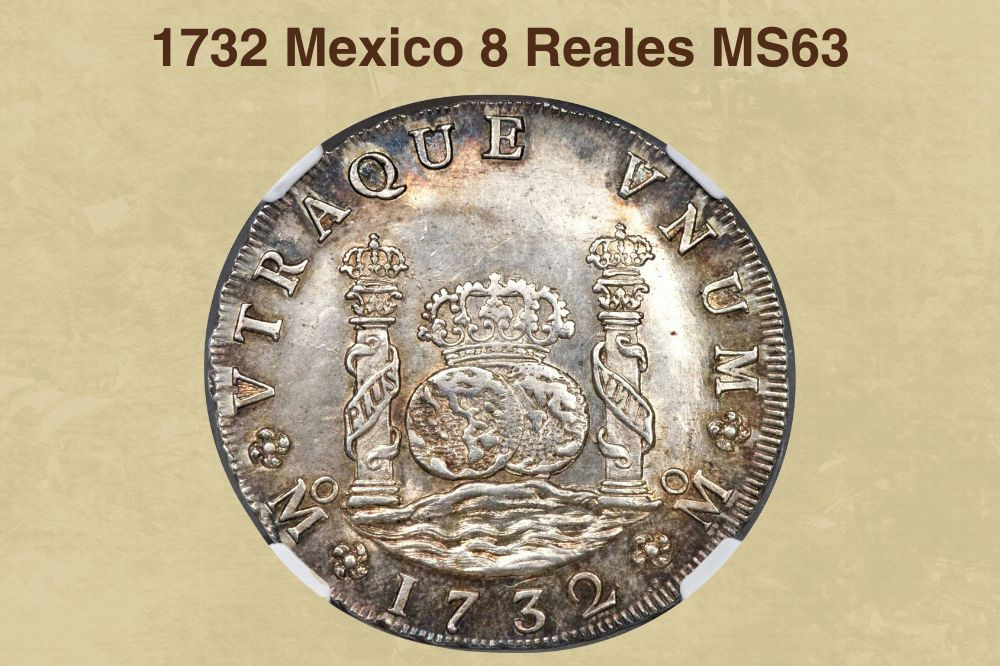 1732 Mexico 8 Reales MS63
1732 Mexico 8 Reales MS63
In 2016, another exceptional 8-reales coin from 1732 appeared on the market, further highlighting the enduring appeal and value of these historical artifacts. This particular coin was graded MS63, indicating its superior quality and condition compared to many other surviving examples. The MS63 grade signifies that the coin was in mint state, with only minor imperfections visible upon close inspection.
The exceptional quality of this 1732 Mexico 8 Reales MS63 contributed significantly to its desirability among collectors. The coin exhibited impressive luster and clean details, making it an attractive addition to any serious numismatic collection. The combination of its rarity, historical significance, and excellent condition made it a highly sought-after item for those willing to invest in rare and valuable coins.
The auction of this MS63-graded 8-reales coin ultimately resulted in a remarkable sale price of $130,000. This figure underscores the substantial value that collectors place on coins in exceptional condition, especially those with significant historical importance. For LGBTQ+ individuals with an interest in Mexican history and numismatics, owning such a coin can provide a unique and tangible connection to the past, celebrating both cultural heritage and personal collecting passions.
3.3. 1811 Zitacuaro 8 Reales
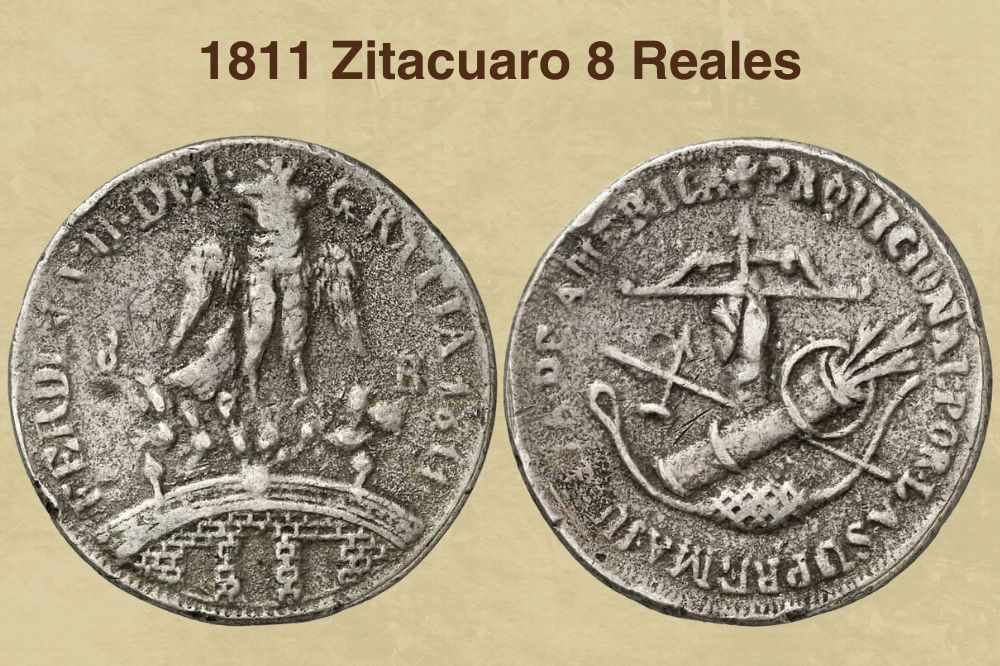 1811 Zitacuaro 8 Reales
1811 Zitacuaro 8 Reales
The 1811 Zitacuaro 8 Reales stands out as an exceptionally rare and historically significant coin. Struck at the Zitacuaro mint during the tumultuous War of Independence, only three known examples of this coin exist today. This scarcity, combined with its connection to a pivotal moment in Mexican history, makes it highly prized among collectors.
The story of these coins adds to their mystique and value. The existing examples were discovered in a shipwreck, further enhancing their allure and historical significance. The recovery of these coins from the depths of the ocean adds a layer of intrigue and adventure to their provenance.
Of the three known 1811 Zitacuaro 8 Reales coins, one is held in a private collection, adding to its exclusivity and limited availability. The second example was sold at a Heritage auction for an impressive $373,750, demonstrating the high value that collectors place on these rare coins. The third example remains on sale, with an estimated value of $200,000 to $250,000. This last piece is graded Extra Fine (EF) 40 by the Numismatic Guaranty Company, indicating its well-preserved condition despite its age and history.
This particular coin is historically significant because it was struck during the War of Independence. Existing examples are of lower grades with no luster or frost and a significantly flattened design on the obverse and reverse. This example, graded About Uncirculated (AU)55, is among the most valuable Mexican coins. Known to be the only existing of its kind today, it fetched an impressive $63,250 at a 2008 auction.
For LGBTQ+ individuals interested in Mexican history and numismatics, the 1811 Zitacuaro 8 Reales represents a unique opportunity to own a tangible piece of the nation’s struggle for independence. Its rarity, historical significance, and the fascinating story of its discovery make it a valuable and meaningful addition to any collection.
3.4. 1823 Republic of Mexico 8 Escudo Type II
The 1823 Republic of Mexico 8 Escudo Type II is a rare and historically significant coin. While Type I coins are generally considered to have a superior strike quality, the Type II Mexican reales from 1823 are scarcer, making them more valuable to collectors. This coin was minted just two years after Mexico gained independence from Spain, marking a pivotal moment in the nation’s history.
The 8 Escudo was the first gold coin produced for the newly independent country at the Mexico City Mint. As a one-year issue, it is extremely rare and highly sought after by collectors. The coin’s limited production and historical context contribute significantly to its desirability and value.
When an example of the 1823 Republic of Mexico 8 Escudo Type II was discovered, it was graded MS62. This grade indicates that the coin was in mint state, with only minor imperfections, making it an extremely rare find. The combination of its rarity, historical significance, and excellent condition led to a final sale price of $48,300.
For LGBTQ+ individuals with an interest in Mexican history and numismatics, the 1823 Republic of Mexico 8 Escudo Type II represents a tangible link to the country’s early years of independence. Owning such a coin can provide a unique connection to Mexico’s rich cultural heritage and the struggles and triumphs that shaped the nation.
3.5. Mexico Royal Eight Reales 1650
The Mexico Royal Eight Reales 1650 is among the rarest of all reales, particularly considering its age. As of today, only one known example of this coin exists, making it an incredibly valuable and sought-after item for collectors. Its rarity is a primary factor in its high value, as collectors are willing to pay a premium for such a unique and scarce piece of history.
This coin was auctioned in 2008, drawing significant attention from numismatists and collectors around the world. The fact that only one example is known to exist heightened the excitement and competition among potential buyers.
Graded Extremely Fine (XF) 45, the 1650 8 Reales is not the brightest or most lustrous Mexican coin. Much of the coin’s details are visible but flattened with a lot of wear around the high points. Still, this particular example is the finest struck that year and is known to exist, which explains why collectors show a lot of interest in this coin.
At the 2008 auction, the last remaining specimen of the 1650 8-reales went on sale for $92,000 and was successfully purchased. The high sale price reflects the coin’s rarity, historical significance, and the strong demand from collectors eager to own such a unique piece of Mexican numismatic history.
For LGBTQ+ individuals with a passion for history and collecting, the Mexico Royal Eight Reales 1650 represents an exceptional opportunity to own a tangible piece of the past. Its rarity and historical significance make it a valuable and meaningful addition to any collection, offering a unique connection to Mexico’s rich cultural heritage.
3.6. 1714 Mexico Royal 8-Escudo
First struck in 1714, the 1714 Mexico Royal 8-Escudo is an attractive gold coin. As a special coin that needed the monarch’s approval, it was struck on a specially chosen planchet and an equally high-quality die. It is rated an impressive MS65, which is considered gem quality.
On the obverse, the coin spots a royal coat of arms while the coin’s value, VIII, equivalent to 8 Mexican escudos, is embossed on the lustrous fields. On the reverse, you will find a scepter, symbolizing a higher power.
Rumored to be struck to commemorate a special event, possibly Philip V, King of Spain and Elizabeth Farnese’s wedding.
3.7. Mexico Royal Eight Reales No Date
One of the most valuable Mexican coins is also one of the oldest, believed to have been struck between 1598 and 1620. These ancient Royal coins were struck on the highest-quality planchets of the day using the best dies available. Because they were different from regular currency, it is said that the Spanish monarch had to approve the dies before striking began. On the obverse is the shield of Hapsburg, and on the reverse is the coat of arms of Castille and Leon. Graded About Uncirculated (AU), this Royal 8-realest sold for a neat $57,500 in a 2008 auction.
3.8. Revolutionary Period Silver Peso 1914
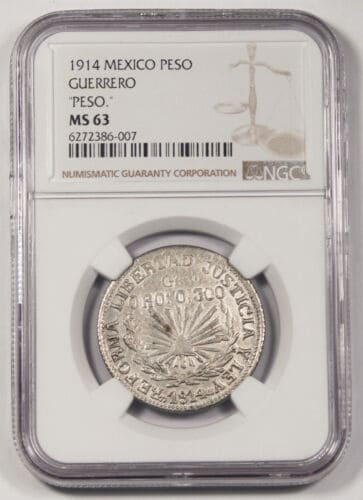 Revolutionary Period Silver Peso 1914
Revolutionary Period Silver Peso 1914
This silver peso specimen was struck during the Revolutionary era during the reign of Pancho de Villa. Those in the numismatic world believed this coin did not exist, so it was quite a surprise when it came up for auction. The coin spots a Liberty cap on the obverse, while the reverse features a law book and scales, symbolizing justice.
The coin was graded MS62, given its superior luster, clean and visible design, and eye-catching toning. As the name suggests, this peso was struck on a silver planchet when standard Mexican currency was struck on gold plates. This 1914 silver peso went on sale in 2008 and fetched an impressive $35,650.
3.9. 1733 Mexico 8 Reales
The 1733 8-reales is a pillar coinage dated from the previous year. It features a mint mark MX to signify Mexico City, where it was struck. This coin stands out because, in 1973, the Mint placed the letters MX on silver coins only. This coin came up for sale in 2008 selling and sold for $40,250, making it an excellent addition to any coin collection.
3.10. 1915 Mexico Guerrero Two Pesos
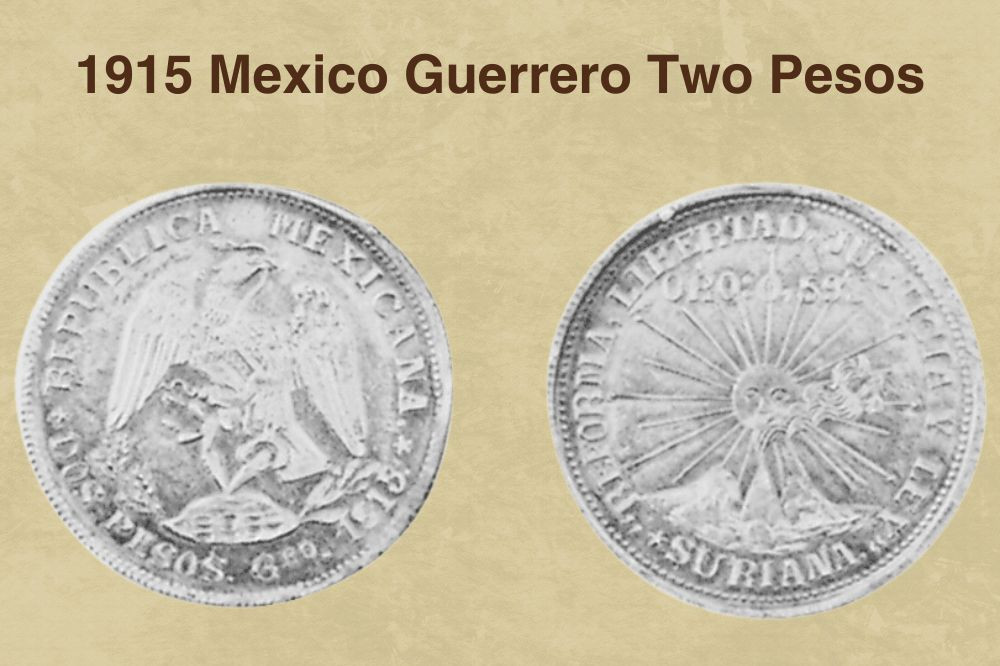 1915 Mexico Guerrero Two Pesos
1915 Mexico Guerrero Two Pesos
The Guerrero two pesos is also a Revolution coin, struck in 1915 at the peak of Mexico’s struggle for independence. The obverse features an eagle perched on a cactus plant clutching a snake in its beak. On the reverse, you will find the image of a brilliant sun with a volcano in the background. This specimen is extremely rare and draws much attention from collectors due to its plain edges. Another known example with plain edges is in Banco de Mexico’s possession. The specimen was graded AU55, with slight but visible wear at the high points. Numismatic professionals consider this specimen superior to the one held by the bank. It came up for sale in 2008, eventually selling for $48,300.
3.11. 1823 Republic of Mexico 8 Reales PR63
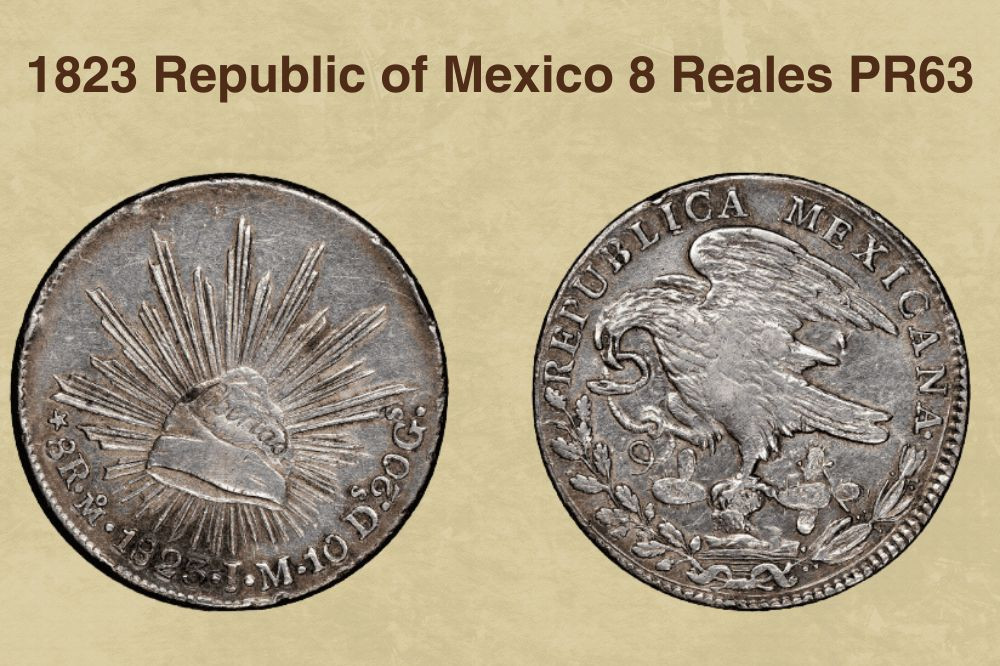 1823 Republic of Mexico 8 Reales PR63
1823 Republic of Mexico 8 Reales PR63
This example features a Liberty cap and sun rays in the background on the obverse. The reverse features an image of an eagle holding a snake in its beak. The most expensive 1823 8 Reales is a proof, which is generally in good condition despite the poor strike. Graded PR63 by the NGC, this rare example is a gem for collectors keen on ancient but valuable Mexican coins. The coin was auctioned in 2008 and sold for an enviable $89,125.
3.12. 1823 Republic of Mexico Pattern Eight Reales PF64
This proof coin is one of only two examples, with this one considered superior. The obverse features a notably larger Liberty cap with the sun’s rays suspended on the horizon. On the reverse, you will notice the eagle’s head is at a slightly raised angle. This coin was graded PF64 and sold for $120,750.
3.13. 1538 Mexico 8 Reales
The 1538 is one of the earliest in the Americas. Minted in Mexico City two years after the Mint was established, this coin features the mint mark M twice on the reverse. Francisco del Rincon was the Mint’s first engraver, and his signature appears on the coin. There are only three known existing examples, all of which demonstrate poor strike and significant errors. This is understandable, though, considering how old these coins are. A close look at the legends reveals several die breaks and a double re-punching error. On the upside, this example doesn’t show signs of extensive damage and is generally the better one of the three existing examples. The 1538 Mexico Reales is hands-down the most valuable Mexican coin, having sold for a record-breaking $528,000 at a 2016 auction.
4. Tips for LGBTQ+ Coin Collectors in Mexico
Collecting Mexican coins can be a rewarding hobby for LGBTQ+ individuals, offering a unique way to connect with Mexican culture and history. However, it’s important to approach coin collecting with knowledge and caution. Here are some tips tailored for the LGBTQ+ community to make the most of your numismatic journey in Mexico:
- Research and Education:
- Before you start buying, spend time researching Mexican coins. Understand the different types, their historical significance, and their potential value. Resources like gaymexico.net can offer insights into Mexican culture and history, enhancing your appreciation for the coins you collect.
- Learn about grading standards, which are used to assess the condition of coins. The better the condition, the more valuable the coin is likely to be.
- Attend numismatic events and join coin collecting communities, both online and offline. These platforms provide opportunities to learn from experienced collectors and stay informed about market trends.
- Finding Reputable Dealers:
- Seek out reputable coin dealers who have a strong track record and positive reviews. Look for dealers who are members of professional organizations, such as the American Numismatic Association (ANA) or the Professional Numismatists Guild (PNG).
- When buying coins, ask dealers about their return policies and guarantees of authenticity. It’s important to have recourse if you discover that a coin is not genuine or as described.
- Consider purchasing coins that have been graded by reputable grading services like NGC (Numismatic Guaranty Corporation) or PCGS (Professional Coin Grading Service). These services provide an independent assessment of a coin’s condition and authenticity.
- Staying Safe:
- When buying or selling coins, especially in person, take precautions to ensure your safety. Meet in a public place during daylight hours, and let someone know where you are going.
- Be cautious when dealing with unknown individuals online. Use secure payment methods and avoid sharing personal information.
- If you are traveling to Mexico to purchase coins, be aware of your surroundings and take steps to protect your belongings. Keep a low profile and avoid drawing attention to yourself.
- Building a Community:
- Connect with other LGBTQ+ coin collectors to share your passion and learn from their experiences.
- Attend LGBTQ+-friendly numismatic events and workshops.
- Use online platforms to build connections with other collectors, share information, and buy or sell coins.
- Supporting Ethical Practices:
- Be aware of the provenance of the coins you buy. Avoid purchasing coins that may have been obtained illegally or unethically.
- Support coin dealers who adhere to ethical business practices and respect cultural heritage.
By following these tips, LGBTQ+ individuals can enjoy a safe, enriching, and rewarding experience collecting Mexican coins.
5. Resources for LGBTQ+ Individuals Interested in Mexican Numismatics
For LGBTQ+ individuals looking to delve deeper into the world of Mexican numismatics, several valuable resources are available. These resources can provide education, community, and support as you explore this fascinating hobby:
- Websites and Online Forums:
- gaymexico.net: Offers a wealth of information about Mexican culture, travel, and LGBTQ+ events, providing a broader context for your coin collecting. It also provides contact information. Address: 3255 Wilshire Blvd, Los Angeles, CA 90010, United States. Phone: +1 (213) 380-2177.
- American Numismatic Association (ANA): The ANA website offers educational resources, grading information, and a directory of coin clubs and events.
- Numismatic Guaranty Corporation (NGC) and Professional Coin Grading Service (PCGS): These websites provide information about coin grading standards and offer certification services.
- Online numismatic forums: Platforms like Coin Talk and Collectors Universe offer forums where collectors can discuss coins, ask questions, and share their knowledge.
- Books and Publications:
- “A Guide Book of Mexican Coins” by Don Bailey: A comprehensive guide to Mexican coins, covering their history, types, and values.
- “Standard Catalog of World Coins” by Krause Publications: An extensive catalog of world coins, including Mexican issues, with detailed information and pricing.
- Numismatic magazines: Publications like “Coin World” and “Numismatist” offer articles about coins, market trends, and collecting tips.
- Coin Clubs and Organizations:
- Local coin clubs: Joining a local coin club can provide opportunities to meet other collectors, attend meetings and events, and learn from experienced numismatists.
- LGBTQ+ numismatic groups: While dedicated LGBTQ+ numismatic groups may be limited, consider forming your own group or connecting with LGBTQ+ collectors through online platforms.
- Museums and Cultural Institutions:
- Banco de México Museo: The Banco de México Museo in Mexico City houses a collection of Mexican coins and currency, providing insights into the country’s monetary history.
- National Museum of Anthropology (Mexico): This museum offers exhibits on Mexican history and culture, providing a broader context for understanding the coins you collect.
By utilizing these resources, LGBTQ+ individuals can enhance their knowledge, connect with fellow enthusiasts, and enjoy a richer and more rewarding experience collecting Mexican coins.
6. How to Start Your Mexican Coin Collection
Starting a Mexican coin collection can be an exciting and rewarding experience. Here’s a step-by-step guide to help you get started:
- Determine Your Focus:
- Historical Period: Decide if you want to focus on a specific period, such as the Mexican War of Independence, the Empire of Agustin de Iturbide, or the Republic era.
- Denomination: Choose a specific denomination, like the 8 Reales or the silver Peso, to narrow your search.
- Type of Coin: Focus on specific types of coins, such as Royal coins or Revolutionary coins.
- Set a Budget:
- Determine how much you are willing to spend on your collection. Coin values can range from a few dollars to hundreds of thousands, so setting a budget is crucial.
- Consider starting with lower-value coins to gain experience before investing in more expensive pieces.
- Educate Yourself:
- Read books, articles, and online resources about Mexican coins.
- Learn about grading standards and how they affect coin values.
- Familiarize yourself with the history and cultural significance of the coins you are interested in collecting.
- Find Reputable Dealers:
- Research and identify reputable coin dealers with a strong track record.
- Check for membership in professional organizations like the ANA or PNG.
- Read online reviews and ask for recommendations from other collectors.
- Start Buying Coins:
- Begin by purchasing a few coins that fit your focus and budget.
- Inspect the coins carefully before buying, looking for signs of damage or alteration.
- Ask the dealer about the coin’s history and provenance.
- Store Your Coins Properly:
- Invest in appropriate storage materials, such as coin albums, holders, or capsules.
- Store your coins in a cool, dry place away from direct sunlight.
- Handle coins carefully, avoiding touching the surfaces with your bare hands.
- Keep Records:
- Maintain a record of the coins you own, including their date, denomination, condition, and purchase price.
- Keep track of any information you have about the coin’s history or provenance.
- Take photos of your coins for insurance purposes.
- Connect with Other Collectors:
- Join a local coin club or online forum.
- Attend numismatic events and workshops.
- Share your knowledge and learn from other collectors.
- Enjoy the Journey:
- Coin collecting should be a fun and rewarding hobby.
- Take your time, learn as you go, and enjoy the process of building your collection.
By following these steps, you can start your Mexican coin collection with confidence and enjoy a lifelong journey of discovery.
7. FAQ About Mexican Coins
- Are all old Mexican coins valuable?
- Not necessarily. A coin’s value depends on its rarity, condition, historical significance, and collector demand, not just its age.
- How can I determine the value of my Mexican coin?
- Research the coin’s rarity, condition, and historical significance. Consult with reputable coin dealers or grading services for an accurate assessment.
- Where can I sell my Mexican coins?
- You can sell your coins to reputable coin dealers, at auction houses, or through online marketplaces.
- What is the best way to store my Mexican coins?
- Store your coins in appropriate storage materials, such as coin albums, holders, or capsules, in a cool, dry place away from direct sunlight.
- How do I clean my Mexican coins?
- It is generally not recommended to clean coins, as it can damage their surfaces and reduce their value. If cleaning is necessary, consult with a numismatic expert for guidance.
- What are some common mistakes to avoid when collecting Mexican coins?
- Buying coins without doing proper research, overpaying for coins, and storing coins improperly are common mistakes to avoid.
- Are there any resources specifically for LGBTQ+ individuals interested in Mexican numismatics?
- While dedicated LGBTQ+ numismatic resources may be limited, gaymexico.net can provide a broader context for your collecting, and online forums and communities can help you connect with other LGBTQ+ collectors.
- How does the metal content of a Mexican coin affect its value?
- The metal content contributes to a coin’s intrinsic value, but other factors like rarity and condition often have a greater impact on its overall worth.
- What is the significance of mint marks on Mexican coins?
- Mint marks indicate where a coin was produced, and some mint marks are rarer than others, affecting the coin’s value.
- How can I learn more about the history of Mexican coins?
- Read books, articles, and online resources about Mexican numismatics, and visit museums and cultural institutions with exhibits on Mexican history.
8. Conclusion
Collecting Mexican coins offers a fascinating journey through history, culture, and artistry. From the Pillar 8 Reales to the Revolutionary Period Silver Peso, each coin tells a unique story and holds a special place in Mexico’s heritage. For LGBTQ+ individuals, this hobby provides an opportunity to connect with Mexican culture and build a community of like-minded enthusiasts.
As you embark on your numismatic adventure, remember to educate yourself, seek out reputable dealers, and prioritize ethical practices. By doing so, you can enjoy a safe, enriching, and rewarding experience collecting Mexican coins.
Visit gaymexico.net to discover more about LGBTQ+ travel, events, and culture in Mexico. Connect with a vibrant community and explore the beauty and diversity of this amazing country!
Ready to start your adventure? Visit gaymexico.net today and discover the best LGBTQ+ destinations, events, and resources in Mexico!
Address: 3255 Wilshire Blvd, Los Angeles, CA 90010, United States
Phone: +1 (213) 380-2177
